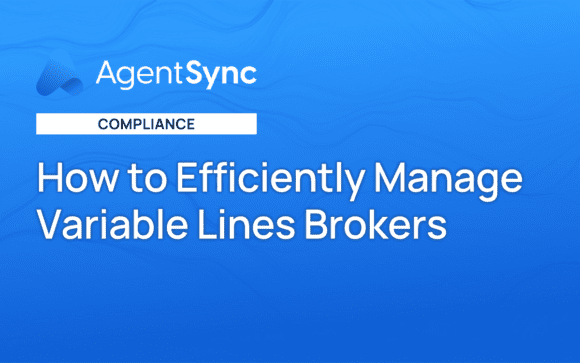How to Efficiently Manage Variable Lines Brokers

This post is part of a series sponsored by AgentSync.
At its fundamental level, compliance is about making sure the people you have selling products are authorized to sell them, and are doing it right away AND the right way. Some compliance efforts are likely already built into your daily activities, like recruiting brokers. But in your efforts to only spend time and money on the right people, are you actually spending unnecessary dollars without truly reducing your compliance risk?
Broker management for insurance producers with securities licenses who sell hybrid, variable products is no small task. Not only are you dealing with the national oversight of FINRA, you’re also dealing with the unwieldy regulatory framework of the insurance industry. That means you’re answering upwards of 50 different jurisdictions in your attempts to be compliant.
While state departments of insurance tend to take pride in having an education-first approach to their regulatory culture, FINRA – and the SEC – tends to take a harder line. And, with variable insurance products near the top of the list as a “leading source of investor complaints,” variable lines broker and compliance management is paramount for carriers and MGAs or MGUs that want to avoid regulatory stumbles (and their accompanying penalties).
What is the variable lines broker’s lifecycle?
The lifecycle for a variable lines broker at any given carrier is the period from onboarding to offboarding (or termination), and what it takes to manage their compliance at every point in between.
A few facets of variable lines business make this more difficult than with a strictly securities-licensed broker or a strictly insurance-licensed producer:
A broker in this case will have two different regulatory sources against which you have to validate their data.
You may have multiple internal compliance teams in different business verticals who’re responsible for this function.
Compliance management during broker recruitment
Those who recruit variable lines brokers may do a high-level compliance check during recruitment, like searching for a prospective broker’s name online to see any big-ticket headlines that pop up. Perhaps they’ll run a name through BrokerCheck and the National Insurance Producer Registry (NIPR) to be sure the financial professional they’re targeting would qualify to sell variable products.
While these are basic steps in the prospecting and recruitment process, many people don’t think of them as compliance activities. But at its fundamental level, compliance is about making sure the people you have selling products can sell them and in the right way. So, in your efforts to make sure you’re only spending money and time on the right people, you’re likely already incorporating some version of compliance into your recruitment efforts.
6 requirements for onboarding a variable lines broker
Onboarding your newly recruited variable lines broker is inextricably linked with compliance. With the right tech and easy processes in place, this is an opportunity to wow your new recruits with frictionless, time- and cost-effective data collection.
Or it’s a mind-numbing exercise in repetition, where multiple teams from the same company ask each broker a new line of questions that are 80 percent the same.
Regardless of whether this is a manual or automated process, though, during onboarding you must:
Collect basic data. This includes:
Proof the broker maintains an E&O policy
Fingerprinting/background check information
W-9
Get relevant agreements signed. Brokers and the entities they work with and represent must have a working contract, so sending drafts back and forth and storing the final draft are essential. With variable lines brokers, this may also include approvals from not only the relevant carriers or MGUs, but also any registered firm or broker-dealers the broker represents.
Verify state insurance licenses. Your broker has to have an active life insurance license or variable-specific license in each line of business and state they’ill sell business in – both their own state and their clients’. This means gathering the national producer number (NPN) to validate against the National Insurance Producer Registry (NIPR).
Verify their Central Registration Depository (CRD) number. Your variable brokers have to have a FINRA registration, having passed a Series 6 or Series 7 exam, and must have a broker-dealer of record. Unfortunately, if you don’t realize your broker provided the wrong CRD, this can be a laborious and headache-inducing process. For instance, in many states a firm selling variable annuities has to have a CRD of its own, and it’s quite common for brokers to mix up their firm’s CRD with their own.
Make appointments. In most states, carriers are responsible for reporting active producers to the state, although some states only require this to be an internal documentation. Still others require carriers to appoint agencies but not individual producers. You’re responsible for following the law of whatever state you’re operating in, including multiple states with conflicting rules.
Verify annuity training. Many states require brokers selling annuities to have a certain number of hours of annuity-specific training before they’re allowed to sell to the public, and this is something you must verify before a broker’s fully onboarded.
How to better manage ongoing broker compliance
It can be easy to dismiss compliance checks as something that happens only once, at the beginning of the relationship, but nothing could be further from the truth.
When a broker is operating out of compliance, and particularly if you’re part of the pipeline of disbursing commissions to that broker, both state departments of insurance and FINRA may be inclined to penalize any carriers or MGAs/MGUs that were responsible for oversight. While the state DOIs may generally take a more education-first approach to compliance issues, variable lines brokers up the ante on compliance risk because FINRA – and, ultimately, the SEC – aren’t particularly forgiving.
As stated previously, a sizable portion of FINRA complaints come from consumers upset about variable lines sales. If such a complaint is the result of a securities broker who’s given bad advice after falling out of compliance – missing continuing education credits, or not having a valid Series 6 or Series 7 license, for example – the carriers allowing such sales can be found at fault.
To be sure you’re protected from these risks, you should be providing ongoing compliance maintenance of your broker force at key points in the business cycle. It’s not that fully licensed brokers can’t perform poorly or induce consumer complaints. It’s just that your liability skyrockets if they do so with compliance issues you should have known about.
For carriers that have regulatory compliance software to maintain tracking, their compliance data synchronizes against FINRA and NIPR sources of truth to maintain accuracy and completeness. Yet, even among the organizations with this level of access to the correct compliance data, there are still two schools of thought. Some insurance carriers are on tech that bills per synchronization, which means the compliance team may be stuck in a cadence of only synchronizing data periodically – monthly, quarterly, or on a narrowly defined “as-needed” basis. Other carriers use regulatory compliance solutions that allow them to synchronize data at a flat monthly rate that keeps their data ecosystem up-to-date every day.
Regardless of which tech solution you subscribe to, on an ongoing basis, you should be validating your broker data in the following ways:
Verify proper license, registration, and appointments before commission payouts. The biggest fines and penalties stem from commission violations, and with the right tech partners and compliance procedures in place, you can stop these violations before they happen.
At license renewal periods. While the ultimate responsibility for renewal lands on the individual broker, you want to be able to stop them from selling at any point they become disqualified.
Track continuing education and product training. Variable lines brokers have more precise requirements than the general producer population for product training and continuing education in most states. In an era of increased scrutiny on annuity sales, these are non-negotiable when it comes to ensuring a compliant sales environment.
Renew carrier appointments. Some states don’t require appointments, and some don’t require appointment renewals, but most states require some sort of renewal, on an annual or biennial basis.
Currently, many carriers and MGAs/MGUs forgo these checks because they lack the supporting software. But, with cloud-based compliance solutions that have robust tech integrations, you can surface license and registration data for your brokers in your existing ecosystem.
In your present state, you may have multiple teams that’d have to click through multiple systems and probably spreadsheets as well to find the necessary information to validate license and registration information before a commission payout. (Likely this cumbersome process is a culprit for why more carriers aren’t currently taking a proactive approach to pre-commission broker validation.) Yet, consider the cost savings in regulatory penalties and staff time if your commission system and your compliance system talked to each other, so variable lines commissions only paid out to a broker if their license and registration were valid for that time period?
How to end a broker relationship
Perhaps a broker is retiring. Or perhaps they haven’t written a policy under your carrier for the past year and you don’t want to pay for an appointment renewal (appointment renewal seasons, amirite?). Or perhaps they are involved in unsavory shenanigans.
Essentially, carriers who must terminate an appointment and offboard a producer have two responsibilities. There may be more to untangle in the relationship depending on your arrangement, but, again, this is specifically in regard to the broker’s compliance management:
Notify the broker in writing of your intent to terminate your agreement and appointment. Many states require a written notice of termination, so this is something you’ll want to keep a record of.
Terminate the carrier appointment with the states, indicating cause if necessary. Some states require carriers to terminate for cause, in which case you’ll need to understand the different allowable causes of termination. Other states are pretty happy with just a name and a date.
Report any potential violations to the state or FINRA. If you’re terminating a broker for cause, you’ll need to disclose any illegal or unethical activity to insurance and securities authorities.
Why variable lines broker compliance management matters
Certainly, there are other things a carrier has to contend with. Marketing, underwriting, actuarial policy building, claims-paying, commission payments, policy administration, client relationship building: Each is a critical part of the mission of insurance. But good broker compliance management supports these other services because, fundamentally, failure to stay in compliance could derail your other work. Following regulatory standards is foundational to being able to operate the rest of your business.
And, aside from the obvious regulatory caveats of “without licensed brokers you can’t legally sell variable lines insurance,” a good broker lifecycle management experience also lets your people do what they do – sell variable lines policies – more efficiently. Less time spent rekeying information and tracking down repeated data or paperwork means more time in front of clients, and more satisfaction with your business, and more retention (of clients and brokers) in the end.
AgentSync Manage’ offers enhanced variable insurance support that unifies FINRA and NIPR data into a single profile, providing a consolidated view of broker eligibility for informed decision-making, accelerated onboarding, and compliance.
If you’re ready for effective, efficient broker compliance to reinforce your other business goals, book a demo and see what AgentSync can help you achieve.
Topics
Agencies





